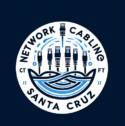Which Pairs Are Used for Ethernet? A Complete Guide to Ethernet Wiring and Color Codes
If you’ve ever looked closely at an Ethernet cable, you’ve probably noticed the colorful twisted wires inside. But have you ever wondered which pairs are actually used for Ethernet? Whether you’re installing a new network, troubleshooting slow speeds, or just curious about how Ethernet works, understanding how these wire pairs function can make a big difference in maintaining a reliable connection.
This guide breaks down Ethernet wiring in simple terms — from color codes to pair usage — so you’ll know exactly how data travels through your network cables. Our team of structured cabling experts in Santa Cruz ensures every Ethernet setup follows proper wiring standards for maximum speed and reliability.
Understanding Ethernet Cable Basics
Ethernet cables, often labeled as CAT5e, CAT6, or CAT6a, are made up of four twisted pairs of copper wires — eight individual wires in total. Each pair is color-coded and twisted to reduce electrical interference and signal loss.
The standard wiring patterns follow TIA/EIA-568A or TIA/EIA-568B configurations, which define how each wire is arranged inside the connector (RJ-45 plug).
The Four Twisted Pairs in an Ethernet Cable
An Ethernet cable contains these color-coded pairs:
- Orange pair – Orange and White/Orange
- Green pair – Green and White/Green
- Blue pair – Blue and White/Blue
- Brown pair – Brown and White/Brown
These pairs aren’t just for organization — each one has a specific electrical purpose depending on the type of Ethernet standard in use.
Which Pairs Are Used in Ethernet Connections?
The answer depends on the Ethernet speed and standard being used. Let’s break it down:
1. 10BASE-T and 100BASE-TX (10 Mbps and 100 Mbps)
- Use two pairs of wires:
- Pair 2 (Orange) – Transmit (TX)
- Pair 3 (Green) – Receive (RX)
- The Blue and Brown pairs are not used for data in these standards.
So, if you’re using an older Ethernet network, only the orange and green pairs are actively sending and receiving signals.
2. 1000BASE-T (Gigabit Ethernet)
- Uses all four pairs for simultaneous data transmission.
- Each pair carries both transmit and receive signals at the same time.
- This setup increases bandwidth and enables speeds up to 1 Gbps.
In Gigabit networks, no wire is left idle — every pair helps achieve faster speeds and better performance.
3. 10GBASE-T (10-Gigabit Ethernet)
- Also uses all four pairs, but at much higher frequencies.
- Requires higher-quality cables such as CAT6a or CAT7 to maintain signal integrity and reduce crosstalk.
So if you’re upgrading your system to support 10-Gigabit Ethernet, make sure you’re using modern cabling designed to handle the additional speed and signal load.
Ethernet Pair Usage Summary
| Ethernet Standard | Speed | Pairs Used | Cable Type |
|---|---|---|---|
| 10BASE-T | 10 Mbps | 2 pairs (Orange, Green) | CAT5 or higher |
| 100BASE-TX | 100 Mbps | 2 pairs (Orange, Green) | CAT5e or higher |
| 1000BASE-T | 1 Gbps | 4 pairs | CAT5e or higher |
| 10GBASE-T | 10 Gbps | 4 pairs | CAT6a or higher |
Why Twisted Pairs Matter in Ethernet
Each pair of wires is twisted together to reduce electromagnetic interference (EMI) from nearby cables and electrical devices. The tighter the twist, the better the cable resists noise and crosstalk — which directly impacts signal quality and network speed.
That’s why CAT6 and CAT6a cables typically perform better than older types. They feature improved insulation, tighter twists, and internal separators that maintain pair spacing for cleaner signals. To better understand the role of cable pairs, check out the two main types of cables used in networking.
How to Identify Wiring Standards: T568A vs. T568B
When terminating Ethernet cables, it’s important to follow one of two wiring standards:
- T568A – Common in residential installations and government projects.
- T568B – More widely used in commercial and industrial setups.
Both standards use the same four pairs, but the color order of the orange and green pairs is swapped. The key is to stay consistent — using the same standard on both ends ensures proper communication.
Choosing the Right Ethernet Cable for Your Needs
If you’re setting up or upgrading a network, here’s a quick guide:
- CAT5e: Great for basic home or office networks (up to 1 Gbps).
- CAT6: Better performance and reduced interference (up to 10 Gbps over short distances).
- CAT6a: Ideal for long runs and 10-Gigabit networks.
- CAT7 / CAT8: High-end performance for data centers or specialized environments.
Professional network cabling installers in California or your local area can help test, certify, and properly terminate cables to ensure maximum performance.
Common Mistakes to Avoid
- Mixing up the orange and green pairs during termination.
- Using different wiring standards (T568A on one end, T568B on the other).
- Using damaged or low-quality cables.
- Ignoring cable length limits (max 100 meters).
- Running Ethernet too close to electrical wiring.
Avoiding these issues helps maintain a strong, interference-free connection.
Key Takeaway
Ethernet cables use specific wire pairs to transmit and receive data — and as network speeds increase, all four pairs come into play. Understanding how these pairs work can help you design, troubleshoot, and upgrade your network more effectively. For outdoor or moisture-prone areas, it’s also worth learning whether LAN cables are waterproof and how they perform in harsh conditions.
If you’re setting up a home office, business network, or upgrading to Gigabit or 10-Gigabit Ethernet, make sure you’re using the right cables, connectors, and wiring pattern for the job.
